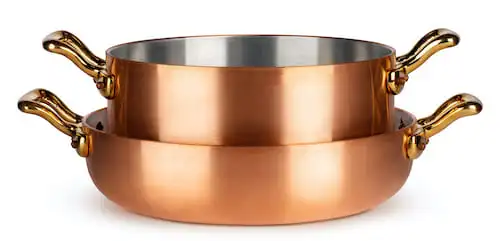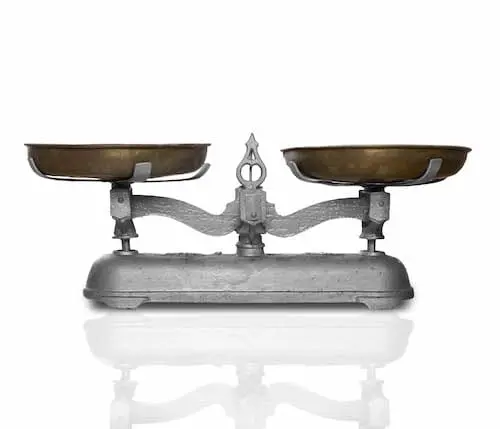This post contains affiliate links. When you buy through our links, we may earn a commission.
You might be surprised to know that copper pots and pans have been used for cooking since the early days of civilization. In fact, they were so prized by the ancient Egyptians and Romans that only the wealthy could afford them.

These days, you can find copper cookware at any price point. But why should you choose copper over other materials?
The benefits of cooking with copper are many. Copper is an excellent conductor of heat, so it heats up quickly and evenly. It also cools down just as quickly, which makes it ideal for controlled cooking. Copper is also highly responsive to temperature changes, so you can easily adjust the heat while you’re cooking.
In this article, we’ll explore what to consider when choosing copper cookware and some tips for cooking with it.
What to consider when choosing copper Pots and Pans:
Copper cookware comes in a range of grades, from very thin and lightweight to thick and heavy. The styles vary, from classic French copper to modern stainless steel-lined copper. When choosing copper cookware, consider what type of cooking you’ll be doing and what your budget is.
Here are a few things to keep in mind when choosing copper cookware:
Lining Materials:

Most copper cookware is lined with another material, such as stainless steel, tin, or nickel. This is because pure copper is soft and reactive. The lining helps to protect food from coming into direct contact with the copper and also makes the cookware more durable.
The most common type of lining is stainless steel. Stainless steel-lined copper cookware is durable and easy to care for. It’s also a good choice if you’re looking for an all-purpose set of pots and pans.
Readers Also Liked:
The Copper Chef -2023 Ultimate Buyer’s Guide
Tin-lined copper cookware is another popular option. Tin is a soft metal, so it heats up quickly and evenly. It’s also non-reactive, so that it won’t affect the taste of food. Tin-lined copper cookware does require some special care, however. It should be washed by hand and not left to soak in water.
Nickel-lined copper cookware is the most expensive option. Nickel is a harder metal than tin, so it’s more durable. It also has a higher heat conductivity, so it heats up even faster. Nickel-lined copper cookware is non-reactive, so that it won’t affect the taste of food.
Thickness and Weight:
Copper cookware is available in a range of thicknesses, from very thin to very thick. The thicker the copper, the better the heat conductivity and the more durable the cookware. However, thick copper cookware is also heavier and can be more difficult to handle.

If you’re starting out with copper cookware, we recommend choosing a set that’s on the thinner side. This will be easier to use and won’t break the bank. As you get more experience cooking with copper, you can upgrade to a thicker set.
Finish:
Copper cookware is available in two different finishes: polished and uncoated. Polished copper has a shiny finish and is less likely to develop a patina over time. Uncoated copper has a more natural finish and will develop a patina with use.
If you’re unsure which finish choosing, we recommend starting with a polished set. You can always switch to an uncoated set later if you decide you prefer the patina. The choice is really up to you and your style.
Size and Shape:

Copper cookware is available in a variety of sizes and shapes. When choosing a set, consider what type of cooking you’ll be doing and how many people you’ll be cooking for. If you’re an experienced cook, you might want to choose a larger set with more versatile pieces. If you’re just starting, a smaller set with basic pieces will suffice.
As far as shape goes, copper pots and pans come in a variety of shapes and sizes. The most common are round, oval, and square. Choose the shape that best suits your needs. Some copper cookware sets also come with lids. If you plan on doing a lot of braising or stewing, we recommend choosing a set with lids.
The type of food you’ll be cooking will also dictate the size and shape of the cookware you choose. For example, if you plan on doing a lot of frying, you’ll want to choose a set with a large frying pan. If you plan on doing a lot of baking, you’ll want to choose a set with a large baking sheet.
Tips for cooking with copper Pots and Pans:
1. Use moderate heat:
Copper is a good conductor of heat, so it heats up quickly. That means you don’t need high heat when cooking with copper cookware. In fact, using too much heat can damage the cookware and affect the taste of your food. The best way to cook with copper is to use moderate heat.
2. Don’t use acidic foods:
Copper is a reactive metal so it can affect the taste of food. That’s why it’s best to avoid cooking acidic foods, like tomatoes or citrus fruits, in copper cookware. If you must cook with acidic foods, we recommend using tin-lined or nickel-lined copper cookware.
3. Don’t let food stick:
Copper is a non-stick metal, so food shouldn’t stick to it. However, if the food sticks, it can be difficult to remove. That’s why it’s important to use the right cooking techniques and ensure the cookware is properly seasoned.
4. Season the cookware:
Seasoning is an important part of cooking with copper cookware. Seasoning helps to create a non-stick surface and prevents food from sticking. It also helps to protect the cookware from damage. To season your copper cookware, simply rub it with a little oil before use.
5. Clean the cookware properly:
Copper is a delicate metal, so it’s important to clean it properly. Avoid using harsh chemicals or abrasive scrubbers, which can damage the cookware. Instead, use mild soap and water to clean the cookware by hand. If you need to remove stubborn stains, we recommend using a copper polish.
6. Store the cookware properly:
Copper cookware should be stored in a cool, dry place. Avoid storing it in direct sunlight or near a heat source, as this can damage the cookware. If possible, store the cookware in a cabinet or cupboard. If you must store it on the countertop, make sure to cover it with a cloth or towel to protect it from damage.
With these tips, you’re ready to start cooking with copper cookware. Copper cookware is a beautiful and functional addition to any kitchen. With proper care, it will last for generations.
Conclusion:
Copper pots and pans are a great investment for any kitchen. They conduct heat better than any other cookware, so food cooked in them comes out evenly cooked every time.
They’re also beautiful pieces that can add a touch of elegance to any kitchen. If you’re looking for the best possible cooking experience, copper pots and pans are the way to go.
